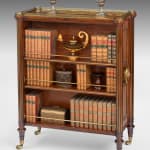Attributed to George Oakley
38 ¼ x 31 x 15 ¾ in
Further images
Provenance
Jeremy Ltd., LondonNorman Adams Ltd., London
Private Collection, UK
Literature
Illustrated in C. Claxton Stevens & S. Whittington, 18th Century Furniture, The Norman Adams Collection, Woodbridge 1983, p. 235.The gilt-brass gallery pierced with a heart motif, with a lobed rectangular top over brass inlaid reeded corner pilasters, two adjustable open shelves to each side also inlaid with brass reeds, the panelled sides with cast water leaf borders and centred with lion's mask and ring handles, on raised turned tapering feet with brass cups and castors.
This is an unusual bookcase designed to be freestanding to be easily moved on its large brass castors. A similar example is illustrated in M. Jourdain, Regency Furniture, London, 1965, fig. 189.
George Oakley (1773-1840) was one of the leading London cabinet-makers of the Regency period. With extensive premises in Bond Street and the City, Oakley undertook commissions for a wide and distinguished circle of patrons, including the Prince Regent, for whom he worked at Carlton House. During a career spanning over half a century he supplied both furniture and upholstery for the Mansion House and the Bank of England, as well as private clients such as the banker Thomas Baring, Lady Cotton of Madingley Hall, Cambridgeshire, and Edward, Lord Lascelles, for whom he worked at Harewood House, Hanover Square.
Rosewood was a material favoured by George Oakley and he was a pioneer in the use of 'Buhl' inlay, Oakley established himself as one of the most original and innovative designers of the period, and his showrooms in Bond Street became a popular destination for fashionable society. As early as 1799 he was granted a royal warrant after receiving a visit from Queen Charlotte and other members of the royal family, on which occasion, it was reported, '... her MAJESTY, the Duke and Duchess of YORK, and the PRINCESSES, &c., highly approved of the splendid variety which has justly attracted the notice of the fashionable world' (Morning Chronicle, May 1799, quoted in Geoffrey Beard and Christopher Gilbert, Dictionary of English Furniture Makers 1600-1840, (1986) p.658). In 1801, the London correspondent of Journal der Luxus und der Moden, a German magazine, wrote that ‘all people with taste buy their furniture at Oakeleys [sic], the most tasteful of the London cabinetmakers.’ Oakley subscribed to Thomas Sheraton’s Cabinet Dictionary, 1803.
Examples of Oakley's trade cards can be found in the British Museum collection: registration nos. Banks,99.31; D,2.4084; D,2.4262; D,2.627 and D,2.644.
Thomas Coulborn and Sons has previously sold several items by or attributed to George Oakley including a pair of brass inlaid rosewood bookcases and a pair of brass inlaid rosewood side cabinets.














